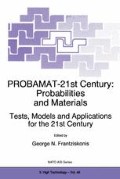Abstract
In heterogeneous materials, cracks are never flat. This observation is however trivial, as the presence of different phases in the material, (voids, inclusions,…) produces stress intensity factor (SIF) modulation along the crack front which has to match the different phase toughness, and hence the crack is deflected, retarded or accelerated leaving in its trail a rough crack surface.
Access this chapter
Tax calculation will be finalised at checkout
Purchases are for personal use only
Preview
Unable to display preview. Download preview PDF.
References
Feder J., Fractals, Plenum Press, ( New-York, 1989 )
Mandelbrot B. B., Passoja D. E., and Paullay A. J., “Fractal character of fracture surfaces of metals”, Nature 308, 721, (1984)
Bouchaud E., “Scaling properties of cracks”, J. Phys. Condensed Matter, 9 4319, (1997)
Bouchaud E., Lapasset G. and Planès J., “Fractal dimension of fractured surfaces: a universal value ?”Europhys. Lett. 13, 73, (1990)
Måløy K. J., Hansen A., Hinrichsen E.L., and Roux S., “Experimental measurements of the roughness of brittle cracks”, Phys. Rev. Lett. 68, 213, (1992)
Daguier P., Nghiem B., Bouchaud E. and Creuzet F., “Pinning and depinning of crack fronts in heterogeneous materials”Phys. Rev. Lett. 78, 1062, (1997)
Bouchaud J. P., Bouchaud E., Lapasset G., and Planès J., “Models of fractal cracks”, Phys. Rev. Lett. 71, 2240 (1993)
Erta D. and Kardar M., “Dynamic roughening of directed lines”, Phys. Rev. Lett. 69 929, (1992)
Erta. D. and Kardar M., “Dynamic relaxation of drifting polymers: a phenomenological approach”, Phys. Rev. E 48, 1228, (1993)
Movchan A. B. and Willis J. R., “Dynamic weight functions for a moving crack. I Mode I loading”, J. Mech. Phys. Solids 43, 319, (1995); Movchan A. B. and Willis J. R., “Dynamic weight functions fora moving crack. II Shear loading”, J. Mech. Phys. Solids 43, 319, (1995)
Rice J. R., Ben-Zion Y., and Kim K. S., “Three dimensional perturbation solution for a dynamic planar crack moving unsteadily ina model elastic solid”, J. Mech. Phys. S.lids 42, 813, (1994); Perrin G. and Rice J. R., “Disordering of a planar crack front in a model elastic medium of randomly variable toughness”, J. Mech. Phys. Solids 42, 1047, (1994)
Vandembroucq D. and Roux S., “Mode III stress intensity factor ahead of a rough crack”, J. Mech. Phys. Solids 45 853–872, (1997)
Vandembroucq D. and Willis J. R., in preparation
Kertész J., Horváth V., and Weber F., “Self-affine rupture lines in paper sheets”, Fractals 1, 67, (1993)
Engoy T., M5.10y K. J., Hansen A. and Roux S., “The roughness of two-dimensional cracks in wood”, Phys. Rev. Lett. 73, 834, (1994)
Gao H. and Rice J. R., “A first order perturbation analysis of crack trappingby arrays of obstacles”, J. Appl. Mech. 56, 828, (1989)
Bak P., Tang C. and Wiesenfeld K., “Self-organised criticality: an explanation of1/f noise”, Phys. Rev. Lett. 59, 381, (1987)
Giamarchi T. and Le Doussal P., “Statics and dynamics of disordered elastic systems”, to be published in “Spin Glasses and random fields” ed. Young A. P., World Sci., ( Singapore, 1997 )
Caroli C. and Nozières P., “Dry friction as a hysteretic elastic response”, in “The physics of sliding friction”, Persson B. N. ed., (1995)
Schmittbuhl J., Roux S., Vilotte J. P. and Måløy K. J., “Pinning of interfacial crack: Effect of non-local interactions”, Phys. Rev. Lett. 74, 1787 (1995)
Erta. D. and Kardar M., “Critical dynamics of contact line depinning”, Phys. Rev. E 49, R2532, (1994)
Sneppen K., “Self-organized pinning and interface growth in a random medium”, Phys. Rev. Lett. 69 3539, (1992)
Paczuski M., Maslov S. and Bak P., “Avalanche dynamics in evolution, growth and depinning models”, Phys. Rev. E 53 414, (1995)
Roux S. and Hansen A., “Interface roughening and pinning”, J. Physique 4 515, (1994)
Schmittbuhl J. and Måløy K. J., “Direct observation of a self-affine crack propagation”, Phys. Rev. Lett. 78, 3888, (1997)
Author information
Authors and Affiliations
Editor information
Editors and Affiliations
Rights and permissions
Copyright information
© 1998 Springer Science+Business Media Dordrecht
About this chapter
Cite this chapter
Tanguy, A., Gounelle, M., Roux, S. (1998). Crack Roughness. In: Frantziskonis, G.N. (eds) PROBAMAT-21st Century: Probabilities and Materials. NATO ASI Series, vol 46. Springer, Dordrecht. https://doi.org/10.1007/978-94-011-5216-7_5
Download citation
DOI: https://doi.org/10.1007/978-94-011-5216-7_5
Publisher Name: Springer, Dordrecht
Print ISBN: 978-94-010-6196-4
Online ISBN: 978-94-011-5216-7
eBook Packages: Springer Book Archive

